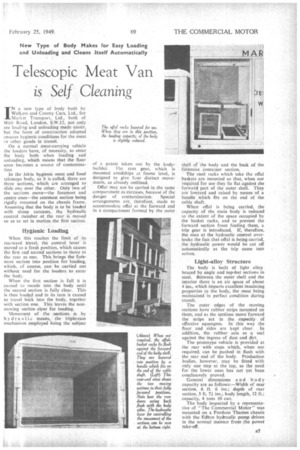Telescopic Meat Van is Self Cleaning
Page 11

If you've noticed an error in this article please click here to report it so we can fix it.
IN a new type of body built by Walkers and County Cars, Ltd., for Market Transport,. Ltd.,. both of Weir Road, London, S.W.I2, not only are loading and unloading made easier, but the form of construction adopted ensures hygienic conditions for the meat or other goods in transit.
On a normal .n-teat-carrying vehicle the loaders have, of necessity, to enter the body both when loading and unloading, which means that the floor soon becomes a source of contamina
tion. • In the Jekka hygienic meat and food telescope body, as it is called, there are three sections, which are arranged to slide one over the other. Only two of the sections move—the fiaremost and centre ones—the rearmost section being rigidly mounted on the chassis frame. Assuming that the body is to be loaded with sheep carcases, the hydraulic control member at the rear is moved so as to set in motion the first section.
Hygienic Loading When this reaches the limit of its rearward travel, the control lever is moved to a fresh position, which causes the first and second sections to Move to the rear as one. This brings the foremost section into position for loading, which, of course, can be carried out without need for the loaders to enter the body.
When the first section is full it is caused to recede into the body until the second section is fully clear. This is then loaded and in its turn is caused to travel bdek into the body, together with section one. This leaves the nonmoving section clear for loading.
Movement of the sections is by hydraulic means, the triple-ram mechanism employed being the subject
of a patent taken out by the bodybuilder. The ram gear, which is mounted amidships at frame level, is designed to give four distinct movements, as already outlined.
Offal may not be carried in the same compartment as carcases, because"of the datger of _contamination. . Special arrangements are, therefore,, made to accommodate offal at the forward end in a compartment formed by the outer.
shell Of the body and the back of the fciriemOst 'container section,
" The steel racks which take the offal baskets are mounted so that, when not reqUired for use they fie flaaagainst the forward part of the outer shell. They are lowered and raised by means 'of a handle which fits on the end of the Cable Shaft.
When offal is being carried, the capacity of the main body' is reduced to the extent of the space occupied by the basket racks, and to prevent the forward section from fouling them, a trip -gear is introduced. If, therefore, the. man at the hydraulic control overlooks the fact that offal is being carried, the .hydraulic power would be cut off automatically as the trip came into action.
• Light-alloy Structure
The body is built of light alloy braced by angle and top-hat sections in steel. Between the outer shell and the interior there is an air space of about 4 ins., which imparts excellent insulating properties to the body, the meat being maintained in perfect condition during transit.
The outer edges of the moving sections have rubber strips mounted on them, and as the sections movelorward the strips act in the capacity, of effective squeegees. In this way the floor and sides are kept clear .in addition, the rubber acts as a' seal against the ingress of dust and dirt.
The prototype vehicle is provided at the rear with steps which, when not required, can be pushed in 'flush with the rear end of the body. Production bodies, however, may be fitted with only one step at the top, as the need for the lower ones has not yet been conclusively proved.
General dimensions and body capacity are as follows:—Width of rear section, 6 ft. 6 ins.; depth of rear section, 3 ft. 7i ins.; body length, 12 ft.; capacity, 4 tons 10 cwt.
The body inspected by a representative of "The Commercial Motor" was mounted on a Fordson Thames chassis with the F-dbro hydraulic pump driven in the normal manner from the power take-off.




























